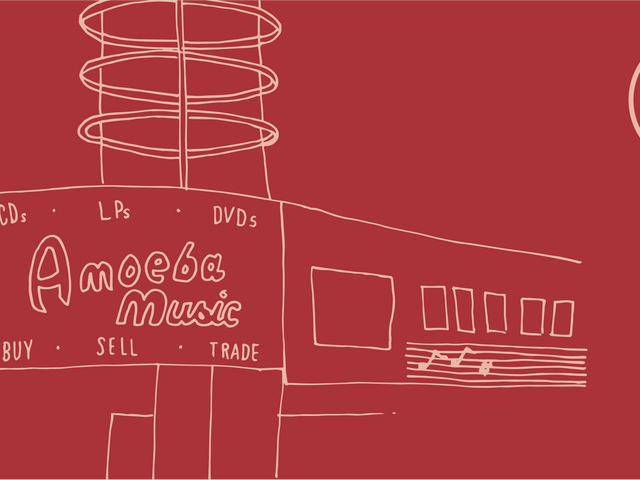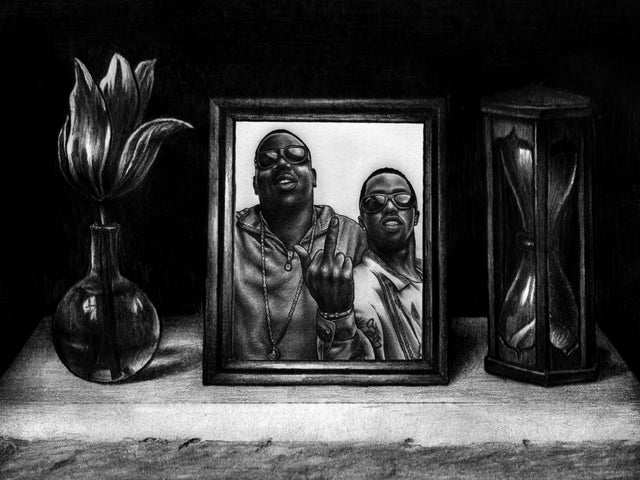Lost Padre Records adalah toko rekaman terbaik di New Mexico
50 Toko Vinyl Terbaik di Amerika adalah serangkaian esai di mana kami berusaha menemukan toko vinyl terbaik di setiap negara bagian. Toko-toko ini belum tentu memiliki harga terbaik atau pilihan yang paling mendalam; Anda dapat menggunakan Yelp untuk itu. Setiap toko vinyl yang ditampilkan memiliki cerita yang melampaui apa yang ada di raknya; toko-toko ini memiliki sejarah, mendorong rasa komunitas, dan memiliki makna bagi orang-orang yang sering mengunjunginya.
Santa Fe hasn’t always had that feeling you get from the right record store — an electric humming hub where you’re just as likely to run into the members of every band worth hearing in town as you are to score a properly priced LP you’ve been searching for your whole life. The kind of place where you can flip through LPs and flit away the hours without even realizing it, while talking bands or even debating the finer points of where to find the best green chili cheeseburger in town. While other record sellers have carved out their niches in this high desert town with respectable results, none of them have accomplished what George Casey has with his Lost Padre Records in just over one short year.
A transplant to Santa Fe from New York, George effuses a worldly cool in a way that only the best music gurus can. No pretension, just knowledge and passion. He’s a font of stories, having booked some incredible-sounding gigs back in the big city, and I’ll usually blow past my time on the parking meter outside when I stop in, often having to cut George off in mid-sentence with a panicked “hold that thought, I’m gonna get a ticket!” (The parking enforcement in Santa Fe is no joke). Of personal interest to me, he used to book some of my favorite bands in New York and he keeps trying to bring garage punk to Santa Fe for good — a noble, if foolhardy, endeavor that we share.
But his knowledge runs broad as it does deep, and his vision cultivates a perfect culture in a humble home with carefully collected bins and always an oddity playing on the speakers. What he’s really done that integrates so seamlessly with Santa Fe, though, is he’s created a space for locals — especially musicians. Santa Fe is on the map for a lot of things, mostly visual art galleries and as a tourist destination. It’s hard to get a gig sometimes if you can’t play bluegrass while smiling for three hours on a patio. For this reason, Santa Fe has become a hotbed for offbeat and DIY venues — specializing in death metal, avant-garde noise sets, and anything that you can’t book anywhere else. People like George help grow that spirit, and he’ll always be one of the first to offer you a place to play in his store, and will stock your music on his shelves.

That kind of local love doesn’t come easy. In my own work as a musician in this town, I used to feel invisible. The first time I met George he shook my hand and said he knew my band because he’d already seen us play. He’d been in Santa Fe maybe a couple of months, but he already knew who I was and liked my stuff. That really encapsulates what makes staying in Santa Fe worth it. You might feel invisible a lot of the time — and God knows I won’t be playing the Bandstand in the Santa Fe Plaza downtown any time soon — but there are always people that care and make everyone around them stronger.
Not to paint a picture of haves and have-nots or host a pity party, but Santa Fe can be a tough paradise to live in. There’s never a shortage of rich tourists in town for Spanish Market (one of the year’s big draws for art vendors) who will stop you on the street like locals are their personal valets. And man, if you don’t know the street address of the cocktail lounge they’re looking for then you’d better prepare for the most withering of glares. It’s like the whole city is one gigantic southwestern theme park and locals are all employees. Throw into that our affordable housing crisis — rent and living costs can be comparable to cities literally fifty times our size — and vast economic disparity, and on some days it feels untenable for me to try and stay here pecking out a living as a retail goon playing in punk bands.
It’s easy to get cynical here, especially if you don’t believe in astrology or the healing light of crystals that seems to affect those with more money than sense, as well as those of us barely scraping by. I often hear people describe Santa Fe as being inside a bubble, and they mean it in a nice way — like somehow people in Santa Fe have it all figured out — but to me that bubble can sometimes feel like a prison. A “City Different” only insofar as it remains stubbornly out of touch with the outside world. Richard Hell actually lived here once. He had nothing nice to say, summing it up thusly in Artifact: Notebooks from Hell 1974-1980: “The town was a backwater, and worse was the mediocre-artist demographic, with its pretense that it’d rejected corrupt worldly striving for natural Santa Fe. There was no one to talk to.” I’d say it’s gotten better than that, but there’s still a dark sliver of me some days thinking he’d got it nailed.
But I stay here, because at the end of the day there are the kind of vibrant community centers like Lost Padre Records. Not just a record shop, but a place to recalibrate and find your allies. To talk about the good old days, talk about the bullshit, mourn the bands who’ve broken up, and give thanks for the life and music of Fred Cole and Roky Erickson.
Going to a show at Lost Padre is like finding a secret. It’s a small space so it’s generally packed, with the wood floors groaning in occasional lulls between sound. There have been national acts there, notably K Records stalwart Karl Blau, but there’s a heavy focus on what locals are doing. At Lost Padre’s opening party I saw the local acoustic conjunto Lone Piñon for the first time playing regional New Mexican music and other styles. I’d come in mid-song and was struck like hitting a force field. In a daze I turned to a nearby friend during one of the group’s tightly arranged and utterly soul-piercing songs and said, “It kind of makes you realize your music is all bullshit, huh?” He agreed.
That’s a life-changer right there, coming in from the night into a warm glowing room full of friends and absolutely having your musical world smashed open so it can be reformed. And this is why Santa Fe thrives creatively, because of these carved-out spaces and the attitude of wanting something to exist and so you and other true believers make it happen.
I said I feel invisible here sometimes, and maybe that’s because I forgot how invisible I’ve felt elsewhere. Here in Santa Fe, I’ve found it easier than anywhere else to create something new. Maybe it’s partly the size of the town, but more so than that, people here want to make something new when they don’t see it in front of them. There wasn’t a single garage punk band in Santa Fe when I moved here, so I started one. It’s exactly what George did when he moved here. He saw a space to be filled, the kind of shop where people could come together and make something new. So he did it.
At Lost Padre, Santa Fe’s real-deal rock ’n’ rollers, burnouts, working poor punks, country poets, jazz heads and battle-vested thrashers all have a place to belong where their value is known and reinforced. It’s the reason why we keep these shops going, and why Santa Fe is damn lucky to have the best shop in the state.
Luke Henley is a writer and musician based in Santa Fe, NM. With both his writing and his bands Sex Headaches and microdoser he desperately continues to cling to dreams of rock 'n' roll legitimacy.
Related Articles
Bergabung dengan Klub!
Bergabunglah sekarang, mulai dari 44 $Exclusive 15% Off for Teachers, Students, Military members, Healthcare professionals & First Responders - Get Verified!










